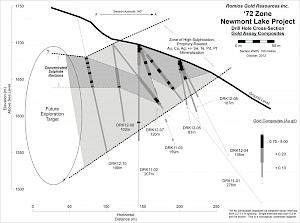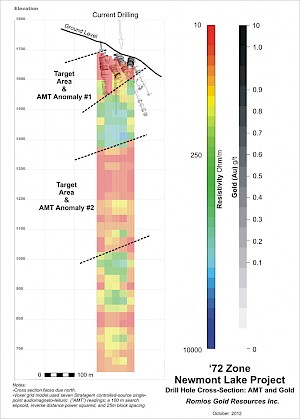TORONTO, ONTARIO (October 10, 2012) - Romios Gold Resources Inc. (TSX.V -RG) ("Romios" or the "Company") is pleased to announce results from its diamond drill program at the '72 Zone. This is the first set of drill results, comprising 6 of 14 holes drilled this summer on Romios' Newmont Lake Project, located in the Golden Triangle district in Northwestern British Columbia. Romios' mineral tenures are located between Pretium Resources' Brucejack deposit, Barrick Gold's Eskay Creek mine, and the Galore Creek Mining Corporation's (GCMC, a NovaGold/Teck Resources' joint venture) Galore Creek project.
Romios first drill-tested the '72 Zone discovery and incorporated the mineral claims into the Newmont Lake Project in 2011 (Press Release dated October 19, 2011). In July 2012, 786 metres of additional drilling at the '72 Zone through sulphide-bearing and brecciated limestone intersected porphyry dykes and numerous, concentrated mineralized horizons containing gold-copper-silver bearing sulphides with anomalous selenium, tellurium, platinum, and palladium.
"I am pleased with this year's drilling program and assays to date," stated Tom Drivas, President and CEO of Romios Gold. "The drilling at the '72 Zone definitely indicates a much larger structure demonstrating good grade and consistent mineralization. We will be planning additional drilling to extend the mineralized zone with the objective of increasing the current resource at Newmont Lake."
Drill holes DRK12-04, DRK12-05, and DRK12-08 confirmed the continuity of precious and base metal mineralization to the northeast from surface exposures. Step-out drill holes DRK12-06 and DRK12-07 intersected mineralization along strike to the southwest. The last hole drilled, DRK12-10, demonstrated widening of the zone toward the west and down-dip, extending the mineralized zone for approximately 200 metres from surface. Drill holes DRK12-07, DRK12-08, and DRK12-10 intersected mineralization with nearly twice the length and concentration of those intervals drilled previously in 2011, indicating strong potential in the area.
In the drilling campaign, the most notable zone of mineralization was encountered in hole DRK12-07 wherein a 5.42 metre (17.78 feet) zone assayed 3.09 g/t gold, 1.33% copper and 27.55 g/t silver. This intercept occurred within a wider zone of mineralization, 10.47 metres (34.35 feet) in width, which assayed 1.67 g/t gold, 0.49% copper and 6.21 g/t silver. A similar intersection was encountered in hole DRK12-08 that measured 10.27 metres (33.69 feet) in width and assayed 0.77 g/t gold, 0.82% copper and 6.90 g/t silver. Hole DRK12-10 intersected a significant width of mineralization, 40.31 metres (132.25 feet), that averaged 0.59 g/t gold, 0.21% copper and 12.07 g/t silver. Within this zone, a high grade silver intersection of 207 g/t over 0.45 metres (1.48 feet) was encountered. Highly anomalous amounts of selenium were found to be associated with the gold, copper and silver mineralization in most of the holes.
Table 1. 2012 drill hole composite assay highlights arranged in the order drilled. "Total" indicates a weighted composite total encompassing the concentrated mineralization from each drill hole; "horizon" indicates the enclosed, higher-grade sulphide horizons within the composite totals; "lower skarn" identifies assay highlights from secondary horizons. DRK12-09 was not completed to target depth.
| Hole ID | Zone | From (m) | To (m) | Total (m) | Total (ft) | Au g/t | Cu % | Ag g/t | Se g/t |
|---|---|---|---|---|---|---|---|---|---|
| DRK12-04 | Total | 1.25 | 14.66 | 13.41 | 44.00 | 0.35 | 0.21 | 1.42 | 0.75 |
| horizon A | 1.25 | 4.98 | 3.73 | 12.24 | 0.53 | 0.37 | 3.27 | 2.49 | |
| DRK12-05 | Total | 1.90 | 16.04 | 14.14 | 46.39 | 0.64 | 0.25 | 2.31 | 1.39 |
| horizon A | 1.90 | 4.07 | 2.17 | 7.12 | 1.04 | 0.74 | 6.42 | 5.84 | |
| horizon B | 7.50 | 7.92 | 0.42 | 1.38 | 4.45 | 0.15 | 2.29 | 0.00 | |
| DRK12-06 | Total | 31.34 | 57.54 | 26.20 | 85.96 | 0.35 | 0.09 | 0.89 | 0.58 |
| horizon A | 56.70 | 57.00 | 0.30 | 0.98 | 8.72 | 1.36 | 11.10 | 7.00 | |
| DRK12-07 | Total | 57.36 | 96.61 | 39.25 | 128.77 | 0.51 | 0.25 | 5.14 | 0.37 |
| horizon A | 86.14 | 96.61 | 10.47 | 34.35 | 1.67 | 0.49 | 6.21 | 1.07 | |
| containing | 91.19 | 96.61 | 5.42 | 17.78 | 3.09 | 1.33 | 27.55 | 2.07 | |
| DRK12-08 | Total | 0.00 | 34.12 | 34.12 | 111.94 | 0.51 | 0.48 | 4.27 | 2.22 |
| horizon A | 0.00 | 10.27 | 10.27 | 33.69 | 0.77 | 0.82 | 6.90 | 6.23 | |
| containing | 0.00 | 2.35 | 2.35 | 7.71 | 1.13 | 0.82 | 7.07 | 4.02 | |
| & containing | 5.67 | 10.60 | 4.93 | 16.17 | 0.90 | 1.18 | 9.46 | 10.07 | |
| horizon B | 18.70 | 20.60 | 1.90 | 6.23 | 1.61 | 1.12 | 7.16 | 2.07 | |
| horizon C | 23.45 | 26.10 | 2.65 | 8.69 | 0.52 | 0.66 | 4.97 | 0.26 | |
| DRK12-10 | Total | 58.54 | 98.85 | 40.31 | 132.25 | 0.59 | 0.21 | 12.07 | 0.24 |
| horizon A | 58.54 | 58.89 | 0.35 | 1.15 | 1.02 | 0.56 | 11.60 | <2.0 | |
| horizon B | 62.30 | 62.75 | 0.45 | 1.48 | 0.03 | 0.04 | 207.00 | <2.0 | |
| horizon C | 64.88 | 65.48 | 0.60 | 1.97 | 0.77 | 0.42 | 6.89 | <2.0 | |
| horizon D | 90.00 | 92.67 | 2.67 | 8.76 | 1.16 | 0.32 | 2.33 | <2.0 | |
| lower skarn | 111.40 | 118.78 | 11.60 | 38.06 | 0.18 | 0.02 | 0.26 | 0.61 | |
| lower skarn | 149.20 | 162.00 | 12.80 | 41.99 | 0.12 | 0.04 | 0.55 | 0.11 | |
| lower skarn | 193.00 | 195.00 | 2.00 | 6.56 | 0.00 | 0.01 | 38.20 | <2.0 |
The drilling data indicate that gold-copper-silver bearing sulphides occur at the '72 Zone up to approximately 150 metres thick along a 150 metre-long southwest strike, reaching down-dip for 200 metres westward toward an encouraging porphyry target.
Seven single-point audiomagnetotellurics geophysical readings ("AMT") were also conducted at the '72 Zone in July 2012. The AMT readings registered high conductivities from surface down to 190 metres, coincident with the zone of sulphide mineralization tested by the six holes outlined above. Additionally, the AMT readings displayed a second area of high conductivities from 300-500m depth, however, this area has yet to be drill-tested.
The occurrence of the sulphide minerals bornite, digenite, chalcopyrite and chalcocite at the '72 Zone, in addition to anomalous concentrations of selenium (Se) and tellurium (Te), suggest the '72 Zone may be a deep-to-intermediate type of high sulphidation ("HS") epithermal zone. Deep HS types of mineralization often occur along faults or other favourable ground adjacent to or above major mineralizing porphyry systems and often within carbonaceous stratigraphy, as evidenced at Colquijirca (Peru), Chuquicamata (Chile), Bisbee (Arizona), and Butte (Montana).
The '72 Zone occurs along the margin of an ancient volcanic feature, which hosts additional and undrilled targets at surface along its margins. Two grab samples from one of these undrilled targets- the 'Knob'- assayed 2.06 g/t Au, 2.38% Cu, and 26.3 g/t Ag (sample G0806111), and, 0.04 g/t Au, 1.92% Cu, and 22 g/t Ag, (sample G0806101).
Future exploration priorities in the area include drill testing for large tonnage disseminated copper-gold mineralization within the deep porphyry-hosted parts of the '72 Zone system as interpreted from the AMT geophysical readings. Additional exploration priorities are to identify other carbonate-replacement breccia pipes and structures in the adjacent country rocks (at the 'Knob' and other zones), and for overlying gold-bearing veins and fractures. All of these mineralization types are present on Romios' Newmont Lake Project, where carbonate rocks are widespread and have interacted with sustained intrusion and volcanism, representing significant potential in the Golden Triangle mineral district for one or more deposit types that have been largely overlooked (R.H. Sillitoe, 1999, Styles of High-Sulphidation Gold, Silver, and Copper Mineralisation in Porphyry and Epithermal Deposits).
Drill core from the remaining eight of 14 holes drilled at the Ken and Northwest zones on the Newmont Lake Project have been submitted for assay. Results will be released when received and reviewed by the Company. Plan-view maps, cross sections, and a complete list of drill assays and composites from the '72 Zone can be found on Romios' website at http://www.romios.com/s/Newmont.asp.
As a matter of procedure, all drill core is cut at the camp using an electric-powered core saw, bagged and sealed for shipping to SGS Minerals for processing in Telkwa, BC. In addition to the laboratory's quality control program, a rigorous on-site quality assurance and quality control program is implemented involving the insertion of blanks, standards and splits to ensure reliable assay results.
The technical information contained in this press release has been reviewed and approved by Mr. Scott Close, P.Geo, Exploration Manager and a Qualified Person as defined by National Instrument 43-101.
In other news, the Company wishes to advise that William R. Johnstone has resigned as a Director of the Company but continues to act as Corporate Secretary and counsel to the Company.
About Romios Gold Resources Inc.
Romios Gold Resources Inc., a progressive Canadian mineral exploration company established in 1995, is headquartered in Toronto and is actively engaged in precious and base metal exploration across North America with a primary focus on gold, silver and copper. Romios has significant property interests in British Columbia, Ontario, Quebec and Nevada. The Company is undertaking extensive exploration work on its Galore Creek area properties in British Columbia, which are centrally located between Galore Creek Mining Corporation's large copper-gold-silver deposit and Barrick's high grade gold mine at Eskay Creek.
Neither TSX Venture Exchange nor its Regulation Services Provider (as that term is defined in the policies of the TSX Venture Exchange) accepts responsibility for the adequacy or accuracy of this release.
For further information, please contact:
Tom Drivas, President and Director: (tel) 416-221-4124, (fax) 416-218-9772 or (email) romios@romios.com
Scott Close, M.Sc, P.Geo., Exploration Manager: (tel) 406-366-3880 or (email) scott@ethosgeo.com
Thomas Skimming, P.Eng, Vice-President, Exploration and Director, (tel) 416-444-0900 or (email) tmsk8ing@hotmail.com
Michael D'Amico, CFO, Investor Relations: (tel) 647-500-6023 or (email) Michael@baystreetconnect.com
Exchange Listings and Symbols: TSX-V:RG, NASDAQ OTC:RMIOF, Frankfurt:D4R.
Head Office:
25 Adelaide Street East, Suite 1010
Toronto, ON Canada, M5C 3A1
Tel: 416-221-4124, Fax: 416 218-9772
Website: www.romios.com
Cautionary Note Regarding Forward-Looking Statements: This Press Release contains forward-looking statements that involve risks and uncertainties, which may cause actual results to differ materially from the statements made. When used in this document, the words "may", "would", "could", "will", "intend", "plan", "anticipate", "believe", "estimate", "expect" and similar expressions are intended to identify forward-looking statements. Such statements reflect our current views with respect to future events and are subject to such risks and uncertainties. Many factors could cause our actual results to differ materially from the statements made, including those factors discussed in filings made by us with the Canadian securities regulatory authorities. Should one or more of these risks and uncertainties, such actual results of current exploration programs, the general risks associated with the mining industry, the price of gold and other metals, currency and interest rate fluctuations, increased competition and general economic and market factors, occur or should assumptions underlying the forward looking statements prove incorrect, actual results may vary materially from those described herein as intended, planned, anticipated, or expected. We do not intend and do not assume any obligation to update these forward-looking statements, except as required by law. Shareholders are cautioned not to put undue reliance on such forward-looking statements.


